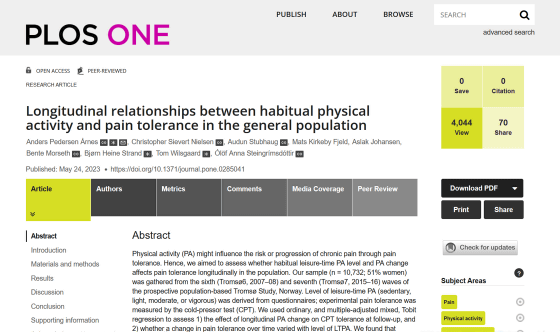As a result of research that ``people with exercise habits have high pain tolerance,'' exercise may be effective in reducing chronic pain

Although exercise is widely recognized for its many physical and mental benefits, its impact on pain tolerance has been less well-studied. A new study of more than 10,000 adults found that people who exercised regularly had better pain tolerance than those who did not.
Longitudinal relationships between habitual physical activity and pain tolerance in the general population | PLOS ONE

Regular Exercise Could Increase Your Tolerance For Pain : ScienceAlert
https://www.sciencealert.com/regular-exercise-could-increase-your-tolerance-for-pain
Exercise May Help You Improve Pain Tolerance | Time
https://time.com/6283513/exercise-improves-pain-tolerance/
A Norwegian research team investigated the pain tolerance of 10,732 people collected in a large longitudinal study in Tromso , a city in northern Norway, to investigate the effect of exercise habits on pain tolerance. Minutes of experimental data were obtained.
This experiment is a cold presser test that `` measure how long you can withstand pain by having your hands immersed in a container containing ice water '', and was conducted twice with an interval of 7 to 8 years. . In addition, the subjects also answered questionnaires on exercise habits etc. at the time of each experiment, and the research team collated these data and conducted analysis.

The analysis also found that more active people could tolerate the pain of ice water for longer than inactive people. It was also shown that those who had increased activity levels at the second time compared to the first time had better pain tolerance after the second time than the first time.
Specifically, those who reported having a moderate level of regular exercise were able to keep their hands in the ice water for an average of 6.7 seconds longer than those who did not exercise at all. Those who regularly exercised vigorously increased their hand soaking time in ice water to an average of 16.3 seconds, and those who had a habit of exercising vigorously during the two measurements increased their time to an average of 20.4 seconds. It is said that
The research team said, ``People who were active or who increased their activity were more strongly associated with high pain tolerance than those who did not normally move their bodies.'' increased with greater activity, and increased with increased activity over a period of 7 to 8 years.Physical activity did not significantly change pain tolerance over time, but this is likely due to It is presumed that pain tolerance decreased year by year due to aging.'

In this study, the exercise level was based solely on the subject's self-report, but similar results were shown in a small study in which the subject actually performed aerobic training.
In addition, exercise habits improve not only temporary pain tolerance, but also exercise may reduce the risk of developing chronic pain, which persists for months to years. . ``From these research results, we found that increasing activity may reduce or prevent chronic pain without relying on drugs,'' said the research team.
Related Posts:
in Science, Posted by log1h_ik







